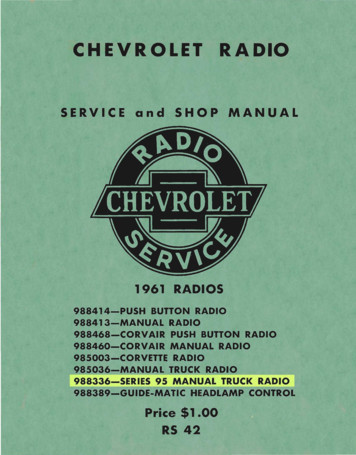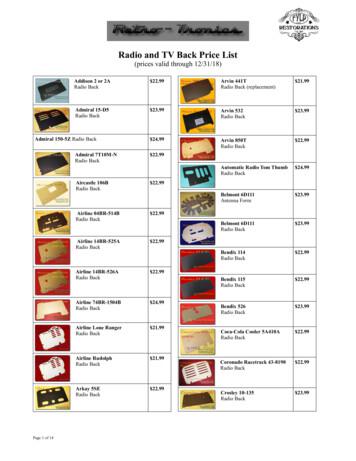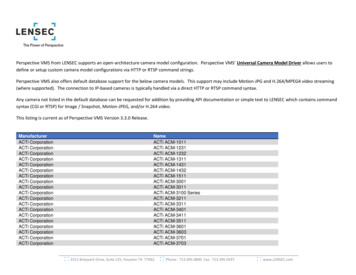A GUIDE TO RADIO COMMUNICATIONS Prepared Under
A GUIDE TO RADIO COMMUNICATIONSSTANDARDS FOR EMERGENCY RESPONDERSPrepared Under United Nations DevelopmentProgramme (UNDP) and the EuropeanCommission Humanitarian Office (ECHO)Through the Disaster Preparedness Programme(DIPECHO)Regional Initiative in Disaster Risk ReductionMarch, 2010Maputo - Mozambique
GUIDE TO RADIO COMMUNICATIONS STANDARDS FOR EMERGENCY RESPONDERS
GUIDE TO RADIO COMMUNICATIONS STANDARDS FOR EMERGENCY RESPONDERSTable of ContentsIntroductory Remarks and Acknowledgments5Communication Operations and Procedures61. Communications in Emergencies .6The Role of the Radio Telephone Operator (RTO).7Description of Duties .7Radio Operator Logs.9Radio Logs.9Programming Radios.10Care of Equipment and Operator Maintenance.10Solar Panels.10Types of Radios.11The HF Digital E-mail.12Improved Communication Technologies.12Satellite Communications.12Benefits of Using Satellite.13Satellite Phones.14Satellite VSAT Networks.152. Radio Procedures.16Guiding Principle of Good Communications .16Sensitive Message Traffic.17Radio Checks and Signal Reports.17Components of All Radio Transmissions.18Call Signs.18Receiving a Message.18Transmitting a Message.19Relay.20i
GUIDE TO RADIO COMMUNICATIONS STANDARDS FOR EMERGENCY RESPONDERSRelay To.20Repetitions.21Corrections.22Canceling Messages.22Read Back.22Acknowledgment of Messages.23Break-In Procedure.23Long Message Procedure.24Phonetic Alphabet.25Pronunciation of Figures.26Mixe Groups.26Standard Procedure Words-(Prowords).27Prowords Listed Alphabetically.27Alert Reports.31Flash Report.33Reports from the field to higher .33Field Flash Report.33Initial Report .33Interim Report .34Specialist or Technical Report .34Message Format.35Note for Assessors.35Examples of Transmission Reports.37Initial Assessment.40General Characteristics of Disaster Events43Landslides, Mud, and Debris Flows.43General Characteristics.43Typical Effects.43Assistance Needs.43Volcanic Eruptions.44General characteristics.44ii
GUIDE TO RADIO COMMUNICATIONS STANDARDS FOR EMERGENCY RESPONDERSTypical Effects.44Assistance Needs.45Tsunamis.45General Characteristics.45Typical Effects.46Assistance Needs.46Earthquake.47General Characteristics.47Typical Effects.47Assistance Needs.47Droughts.48General Characteristics.48Typical Effects.49Assistance Needs.49Floods.50General Characteristics.50Typical Effects.50Assistance Needs.51Chemical and Industrial Accidents.51General Characteristics.51Typical Effects.51Assistance Needs.52Tropical Cyclones.53General Characteristics.53Typical Adverse Effects.53Wind Reference Tables.54iii
GUIDE TO RADIO COMMUNICATIONS STANDARDS FOR EMERGENCY RESPONDERSDisplaced Populations.56General Characteristics.56Typical Effects.56Emergency Needs.56iv
GUIDE TO RADIO COMMUNICATIONS STANDARDS FOR EMERGENCY RESPONDERSIntroductory Remarks andAcknowledgmentsThis manual is written to provide a standard of operation and aguide for training and message handling techniques and netprocedures for Radio Emergency Service operators at thenational and as well as with local radio networks. Instructionsand general operating procedures presented in this StandardOperating Procedure (SOP) are applicable to all message traffichandling. All radio operators are encouraged to use thisdocument in training and/or activated net operations.The United Nations Development Programme (UNDP) andDIPECHO has prepared this document based on standartizedinternational communications protocols. Adaptations weremade to make communications protocols more user friendly tothe target audience comprised of countries such asMozambique, Malawi, Madagascar and Comoros.This document also benefited from combined efforts andvaluable contribution of Dr Jane S. P. Mocellin, a.i DIPECHORegional Coordinator on behalf of UNDP. A consultant , B.Donaldson, have greatly contributed to the process ofpreparation of this document and gave useful advice andsuggestions and finalizing it. Special thanks to WFPMozambique (World Food Programme) for their review on theinitial draft.5
GUIDE TO RADIO COMMUNICATIONS STANDARDS FOR EMERGENCY RESPONDERSCommunication Operations and Procedures1. Communications in EmergenciesEffective communication linkages among the EmergencyOperations Centers (EOC) and front-line responders to meetthe needs of affected communities is critical in the aftermath ofa disaster, especially with the growing emphasis on devolutionof disaster management to the community level. However,failure of electronic communications has been a majorproblem on numerous occasions impeding disaster response.In addition to rapid response, there is also a requirement forcontinued community information post-impact, such aswarnings of additional threats and of emergency/disastermanagement arrangements in their local areas. The goal of anycommunication system is to maximize the number of peoplewho take appropriate and timely action for ensuring safety andprotecting of life and property of affected communitiescommunication systems. It should encompass three equallyimportant elements:?Detection and warning;?Dissemination of warning down to the communitylevel; and?Subsequent quick response.Developing and implementing common technical characteristics and guidelines for radio communication systems for earlywarning and disaster relief, would promote a commontechnical basis in planning for and responding effectively to anemergency. Such systems that have a common basis, wouldalso benefit from cooperation among countries when there is a6
GUIDE TO RADIO COMMUNICATIONS STANDARDS FOR EMERGENCY RESPONDERStrans-border disaster by allowing an effective and appropriatehumanitarian assistance with all the necessary operational requirements.Basic radio operating procedures are used for the followingreasons:?Non-standard radio communications can result inmisunderstood messages;?Terminology and procedures used to exchange information vary among different organizations;?In emergency or poor operating conditions, radio traffic becomes congested and accuracy can suffer; and?Information may be easily compared thus the work ofdifferent assessment teams is complementary.The Role of the Radio Telephone Operator (RTO)Emergency communications are not a just function of technology and access alone. Information flows in cascades andchains, between the point of origin and ultimate use. Suchcascades often involve multiple actors and points whereinformation is interpreted, reformulated, and transmitted tothe next set of actors. The emergency communication RadioTelephone Operator (RTO) is responsible for ensuring thatinformation during disaster response or crisis managementactivities is quickly and accurately passed to all agencies involved in the response operation.Description of DutiesThe RTO performs the following duties:?Maintains radio contact with all stations and vehicles7
GUIDE TO RADIO COMMUNICATIONS STANDARDS FOR EMERGENCY RESPONDERSin radio network(s) under their responsibility;Ensures efficient communications and information?flow for all units and Agencies;?Communicates with all applicable supportingnetworks including the United Nations (UN) and relevant Non-governmental Organizations (NGOs) in theregion ensuring radio communications for operational and security purposes;?Logs all communications and dispatch without delayto the receiving Officer or Unit (database entry asapplicable);?Keeps all necessary messages sent and received strictly confidential;?Ensures all network users are complying with properradio procedures, and full call signs are enforced,English language, etc. is strictly adhered to;?Advises radio room supervisor immediately of faultsin the telecommunication networks and undertake allnecessary actions to provide a prompt reestablishment of service. Security is always the main priority;?Assesses overall communications needs, obtainfrequencies, and develop the communications plan asneeded;?Installations, operates, and maintains communications systems, including: radio, satellite, telephone,Internet, Geographic Positioning System (GPS 's) andnetworks during incidents;?Adheres to all safety procedures; and?Develops requests for replacement, or repair, for consumable, inoperative, lost, damaged, or destroyedcommunications items.8
GUIDE TO RADIO COMMUNICATIONS STANDARDS FOR EMERGENCY RESPONDERSRadio Operator LogsAccurate logs provide a time line and account for assignedpersonnel and resources and are necessary in case your firstresponder needs to receive replies later. Thus whenever amessage is sent or received they need to be recorded in aLogbook. The Emergency Operations Center (EOC) communications manager must check the logbooks at least each dayto make sure that messages were passed on and were notforgotten.Use the mnemonic ASAP as an aid to information management:ACCURATE: Precise, clear.SPEEDY: Quickly copied and deliveredAPPROPRIATE distribution: The right person gets theinformationPERMANENTLY recorded.Radio Logs?All messages received either by phone or radio shouldbe logged before being dispatched;?All outgoing satphone calls should be logged in anappropriate sheet; and?All contacts should mainly be on High Frequency (HF)or Very High Frequency (VHF). All telephone callsshould be logged or entered in the database ormanual record as applicable.Log Format ExampleCall FromCallsMessage Text TimeAction TakenAB 21BaseFlash report# 24Filed withEoC manager16:509
GUIDE TO RADIO COMMUNICATIONS STANDARDS FOR EMERGENCY RESPONDERSProgramming RadiosMost modern radios offer a digital selective call (Selcall)encoding facility that allows programming in the frequenciesof several other stations. By entering the identity number ofany of these stations, the radio at the receiving end, rings like atelephone. The Selcall feature can be used in conjunction withan emergency button. By pressing the button, a distress call isautomatically sent to all the numbers programmed. Atechnician can do this, but it is up to the individual responder toensure the assigned communication equipment is properlyfunctioning and has the appropriate channels/ frequencies.Care of Equipment and Operator MaintenanceCommunications equipment should be installed and servicedonly by qualified technical personnel. However, operatorsshould perform regular maintenance as follows:?Visually check of all connections, wires and antennas;?Scheduled 'on air' testing;?Keep batteries charged and remove dry cells batteriesfrom equipment in storage;?Keep the radio clean, dry, and dust free; and?Check all accessories.If a fault is found, the radio should be labeled and the faultdescribed with sufficient information to aid repair and return ofthe repaired item. Accessory items should also be included.Solar PanelsSolar panels typically deliver 15 to 18 Volts (V) at 600 to 1 500milliamperes (mA) in full sunlight. This will not damage a high10
GUIDE TO RADIO COMMUNICATIONS STANDARDS FOR EMERGENCY RESPONDERScapacity battery, such as a deep-cycle unit. All you need to do ishook up the battery, put the solar panel in full sunlight, andcharge. The battery will regulate the maximum voltage fromthe panel. Most are polarity protec-ted with a diode in serieswith the positive voltage line, so when it gets dark, and theoutput voltage drops, the diode ensures that the panel won'tstart drawing current from the battery.Communication equipment are expensive items, easilymislaid and attractive to thieves. All staff is advised to keeppositive control of their assigned equipment at all times.When using a solar panel to recharge a smaller battery, such asa Nickel-Cadmium (NiCd) battery or gelled-electrolyte leadacid battery, more attention to detail is required. These types ofbatteries can suffer damage if charged too quickly, so a regulated charge is necessary.Types of RadiosLong-range radios are HF radios, which can communicateseveral hundred kilometers and in some circumstances, severalthousand. HF radio is the backbone of communications toremote areas. It may not be a fast means of delivering largeamounts of data, but it still has a vital role to play in two-wayaccess to remote areas. HF should be retained as a backupnetwork where better and more sophisticated solutions existas many of these fail during severe weather and naturaldisasters. By adding relatively inexpensive digital modems, areasonable quality digital data communications system can beimplemented.11
GUIDE TO RADIO COMMUNICATIONS STANDARDS FOR EMERGENCY RESPONDERSThe HF Digital E-mailHF e-mail is a low cost system in terms of hardware andoperational costs. It is good for long distance communicationoffering longer transmission than voice.Short-range radios are usually Very High Frequency (VHF)radios. They can communicate a few kilometers directly (lineof-sight), but using a repeater station (on a hilltop or a highbuilding) can increase their capacity to several tens ofkilometers. Typical ranges for VHF radios are:?Handheld to handheld: 2 - 5 km;?Vehicle unit to vehicle unit: up to 20 km;?Base unit to handheld: up to 15 km;?Base unit to vehicle unit: up to 30 km; and?Base unit to base unit: up to 50 km.Improved Communication TechnologiesThe new communication and information technologies thathave emerged over the last two decades lend themselves togreater possibilities of integration of different communicationsystems. The interoperability of various communicationsystems including Internet, mobile phones, fax, and e-mail, isincreasingly becoming functional. As a result, the possibilitiesfor application of communication technologies in mitigation,prevention, and response to disasters, are also increasing.Satellite CommunicationsA lesson learned from recent disasters, was the power of thesatellite-based communications for disaster management.While conventional communications outlets (i.e., wireless12
GUIDE TO RADI
Commission Humanitarian Office (ECHO) Through the Disaster Preparedness Programme . international communications protocols. Adaptations were . Emergency communications are not a just function of tech-nology and access alone. Information flows in cascades and
SERVICE and SHOP MANUAL 1961 RADIOS 988414-PUSH BUTTON RADIO 988413-MANUAL RADIO 988468-CORVAIR PUSH BUTTON RADIO 988460-CORVAIR MANUAL RADIO 985003-CORVETTE RADIO 985036-MANUAL TRUCK RADIO 988336-SERIES 95 MANUAL TRUCK RADIO 988389-GUIDE-MATIC HEADLAMP CONTROL Price 1.00 . 89 switch and must be opened by speaker plug when testing radio.
Wavestown Answer Key Radio Waves Ray’s TV - TV reception uses radio waves Satellite Dish on top Ray’s - receives movies via radio waves from a satellite Taxi - Car radio reception uses radio signals Taxi - Driver receives instructions on a CB radio which uses radio waves Radio Tower - broadcast’s radio signals
Radio and TV Back Price List (prices valid through 12/31/18) Addison 2 or 2A Radio Back 22.99 Admiral 15-D5 Radio Back 23.99 Admiral 150-5Z Radio Back 24.99 Admiral 7T10M-N Radio Back 22.99 Aircastle 106B Radio Back 22.99 Airline 04BR-514B Radio Back 22.99 Airline 14BR-525A Radio Ba
Axis Communications AXIS 215 PTZ-E Axis Communications AXIS 216FD Axis Communications AXIS 216FD-V Axis Communications AXIS 216MFD Axis Communications AXIS 216MFD-V Axis Communications AXIS 221 Axis Communications AXIS 223M Axis Communications AXIS 225FD Axi
Radio communications for the fire service has evolved considerably over the last 60 years. . When talking about fire department communications systems usually we are talking about what are traditionally called land mobile radio systems. It is important for firefighters and fire officers to have a basic knowledge of radio system technologies .
1988 Honda Accord AUDIO WIRING WIRE COLOR LOCATION NOTES RADIO CONSTANT BLUE/WHITE Radio Harness RADIO GROUND YELLOW/RED Radio Harness RADIO SWITCHED BLACK Radio Harness LEFT FRONT SPEAKER ( ) BLUE/GREEN Radio Harness Or Speaker LE
Cognitive Radio “Radio etiquette is the set of RF bands, air interfaces, protocols, and spatial and temporal patterns that moderate the use of radio spectrum. CR extends the software radio with radio-domain model-based reasoning about such etiquettes.” J. Mitola and G. Q. Maguire, “Cognitive radio: Making software radios more personal,”
cmb salary survey report. benefit data by market rank. 15. salary data for radio revenue 3m. 13. salary data for radio revenue 1-3m. 12. salary data for radio revenue 1m. 11. salary data for radio market rank 101. 10. salary data for radio market rank 26-100. 9. salary data for radio market rank 1-25. 8. salary data for radio stations .























